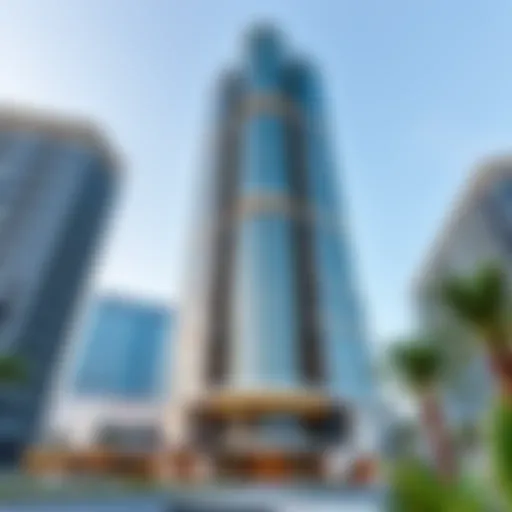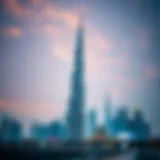Exploring alsouq: Dubai's Traditional Market Dynamics
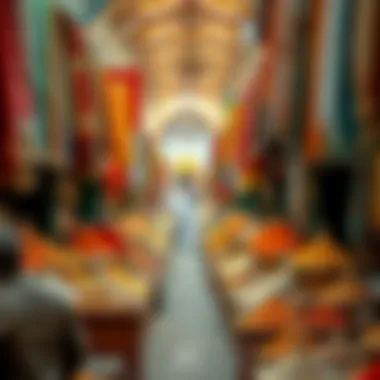

Intro
In the labyrinth of Dubai’s vibrant atmosphere, traditional markets, known as alsouq, serve as both time capsules and modern hubs. They invite residents and visitors alike to explore the deep-rooted history and local culture that characterize this dynamic city. This exploration captures the essence of not just the products sold within these markets, but the places themselves, which echo Dubai’s evolution from a humble fishing village to a sprawling metropolis.
Alsouq's significance extends beyond mere shopping; it represents a microcosm of the rich tapestries of Arab culture. The hustle and bustle, the aromatic spices wafting through the air, and the melodic calls of vendors create an immersive experience for anyone who steps foot into these historic venues. Understanding these markets is, therefore, crucial for those looking to navigate Dubai's real estate landscape.
By interweaving the past with contemporary commerce, the alsouq markets demonstrate how tradition and modernity can coexist harmoniously. The insights gleaned from exploring these markets go beyond what’s available for purchase—they lay bare the cultural, social, and economic pillars that underpin Dubai's growth. This article will unravel the multifaceted relationship between these traditional markets and the city’s evolving property market, providing a roadmap for savvy investors and curious explorers alike.
Understanding Alsouq
The alsouq, a traditional market, holds a pivotal role in the heart of Dubai's cultural and economic landscape. For investors and real estate professionals, understanding the dynamics of alsouq is crucial, as it offers insights into consumer behavior, preferences, and the overall spirit of the community.
At its core, alsouq represents more than just a marketplace; it's a nexus of social interaction, a hub where history, culture, and commerce intersect. Recognizing the significance of alsouq helps stakeholders appreciate the underlying values driving local consumer choices and investment potentials. The integration of tradition within the framework of a modern city such as Dubai enhances its appeal, especially to those looking to connect with the region's rich heritage while navigating contemporary real estate opportunities.
The Historical Context
The roots of alsouq can be traced back centuries, firmly establishing it as a cornerstone of Dubai’s economic backbone. Historically, these markets provided essential goods and services for local communities, creating a vibrant atmosphere that fostered social interaction. The evolution of alsouq reflects the changes in trade, migration patterns, and economic development over the years. In this context, understanding the historical trajectory of alsouq offers contemporary stakeholders a lens through which to view modern challenges and opportunities.
Cultural Significance
Culturally, alsouq serves as a living tapestry of Dubai's diverse population. It not only offers various goods—from spices to textiles—but also acts as a stage for cultural exchange among local residents and tourists. The bustling environment evokes a sense of belonging, with families often passing down traditions associated with shopping, bargaining, and socializing in these marketplaces. For investors, this cultural richness can translate into marketing opportunities, aligned with the sensitivities of local traditions and preferences.
Architectural Elements
The architecture of alsouq is distinctive, characterized by narrow alleyways, wooden beams, and traditional-styled storefronts. These design elements are not merely aesthetic; they reflect the climatic conditions of the region and the social dynamics of trade. The market layout encourages exploration and interaction, creating an experience that starkly contrasts with modern, sterile shopping malls. Recognizing these architectural features can provide developers and real estate agents with inspiration when considering projects that seek to blend modern conveniences with authentic local charm.
The Structure of Traditional Markets
Understanding the structure of traditional markets is crucial, especially in the context of alsouq. These markets are not just mere shopping venues; they are vibrant ecosystems that embody the culture and heritage of the region. The layout, the variety of goods, and the pricing strategies all contribute to a unique shopping experience that cannot be replicated elsewhere. Their significance extends to economic benefits, community engagement, and even tourism attraction, making them a focal point of interest for potential investors and real estate professionals.
Layout and Design
The layout of alsouq is crafted to facilitate a sensory experience, drawing shoppers into a labyrinth of colors, scents, and sounds. Unlike modern malls with their templated designs, traditional markets embrace organic structures. Pathways meander through stalls, often shaded by tents or canopies. Foot traffic flows naturally, allowing visitors to browse at their leisure.
A notable feature is the juxtaposition of open areas for large gatherings alongside narrow alleys for intimate interactions between buyers and sellers. This design fosters a community atmosphere, inviting conversations and negotiations that are fundamental to the market's culture.
Important aspects of layout to consider:
- Accessibility: The ease of movement affects foot traffic and, consequently, sales.
- Spatial Orientation: How the stalls are organized influences customer behavior and spending.
- Cultural Elements: Architectural details often reflect local heritage, enhancing the emotional connection for both buyers and sellers.
Types of Goods Offered
In alsouq, the variety of goods is staggering. One can find anything from fragrant spices and handcrafted jewelry to textiles and traditional pottery. Each stall typically specializes in a particular category, allowing for personalized service and expertise that often feels absent in larger retail chains.
Consider the vibrancy of the spice section, where merchants proudly display their wares. Visitors can expect to engage more deeply with sellers who offer tastes and stories behind each spice. This personal touch is what sets alsouq apart from other markets in the world.
Common categories include:
- Food Items: Fresh produce, meats, and spices.
- Artisan Crafts: Handicrafts, jewelry, and textiles.
- Cultural Goods: Traditional clothing and artifacts that tell the story of Dubai's rich past.
Pricing Mechanisms
Pricing in traditional markets functions differently than in fixed-price retail settings. Negotiation is part of the culture. This encourages buyers to engage in haggling, which can be an enjoyable process as both parties aim for a satisfactory deal. This is particularly fascinating for newcomers who might be unfamiliar with the practice.
Sellers often set a base price, but they expect to negotiate. This dynamic creates a sense of excitement as shoppers feel they have some control over their purchase. Ultimately, the prices fluctuate based on demand, quality, and even the seller's personal philosophy toward bargaining.
Key elements of pricing to consider:
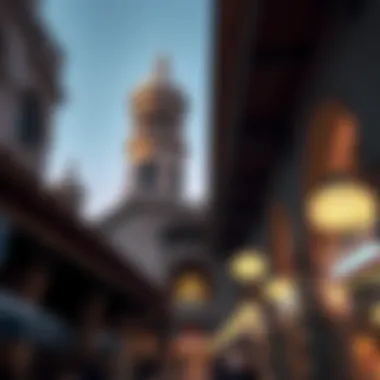

- Flexibility: Encourages buyers to engage more directly.
- Perceived Value: Local perceptions significantly affect what is considered "reasonable" pricing.
- Seasonal Variations: Prices might change with the seasons or during festivals, impacting both shoppers and merchants.
As real estate professionals eye potential investments, understanding the structure of traditional markets like alsouq offers invaluable insights. These markets are more than just commercial spaces; they are embodiments of community culture and economic potential.
Economic Impact of Alsouq
The economic impact of alsouq in Dubai stretches far beyond the exchange of goods; it intertwines with the city's very fabric, influencing local commerce, tourism, and employment. As we explore this intricate web, it's clear that alsouq is not just a marketplace, but a burgeoning economic hub that presents copious opportunities to investors, buyers, and real estate professionals. With its historical roots and cultural significance, alsouq holds the power to shape modern commerce in the emirate.
Local Commerce
When it comes to local commerce, alsouq serves as a vital artery for small businesses and artisans, providing them a platform to reach customers directly. This face-to-face interaction is more than just selling; it creates relationships. Shoppers are inclined to put their money where they feel a connection, and the personal touch found in traditional markets fosters trust. It’s not uncommon for a customer to know the vendor by name, and vice versa.
- Variety of Goods: From spices and textiles to handcrafted goods, alsouq offers an eclectic mix that reflects the diverse cultural background of Dubai. This variety ensures that local merchants can cater to unique tastes, thus enhancing customer loyalty and repeat business.
- Support for Local Producers: By sourcing goods from local producers, alsouq stimulates the regional economy. It encourages community resilience and showcases the quality craftsmanship often lost in larger, modern retail settings.
When local businesses thrive, so too does the larger economy, creating a win-win scenario for both merchants and consumers. The economic ripple effects ensure more money remains within the community, fostering a robust local ecosystem.
Tourism Influence
Tourism in Dubai is a significant component of the emirate's economy, and the alsouq plays a crucial role in this sector. Tourists flock to these traditional markets not only for shopping but for the entire experience they offer. Here’s how alsouq influences tourism:
- Cultural Attraction: Tourists often seek to immerse themselves in the local culture, and alsouq epitomizes that. The traditional architecture, rich aromas, and bustling atmosphere create an authentic Dubai experience.
- Economic Boost: An increase in tourism translates to higher sales for local vendors. Foreign visitors are often eager to purchase unique souvenirs, supporting local artisans and other businesses around the market.
- Events and Promotions: Many alsouqs host events that attract tourists, such as cultural exhibitions or food festivals. These not only provide fun and entertainment but also promote Dubai's rich heritage.
In summary, alsouq isn’t merely a stop on a tourist's itinerary; it’s an economic lifeline that contributes to the flow of cash into local markets.
Employment Opportunities
A bustling alsouq is a significant source of employment for local residents. The jobs created in the markets can have a substantial impact on the community. Here’s a closer look:
- Diverse Job Creation: From vendors and artisans to support staff such as security and maintenance, the market offers a broad range of job opportunities. As small businesses flourish, they often hire more employees, driving down local unemployment.
- Skill Development: Working in traditional markets aids in skill development, enhancing employees' abilities in customer service and sales. This experience not only benefits the individual but builds a skilled workforce for the local economy.
- Encouragement of Entrepreneurship: The accessibility of alsouq serves as a launchpad for budding entrepreneurs. Many small businesses start in these markets, and as they establish success, they may grow into larger operations, further contributing to job creation.
Overall, the employment opportunities presented by alsouq not only bolster individual livelihoods but also strengthen the entire economic framework, benefiting everyone involved.
The alsouq in Dubai acts as a catalyst for economic growth, intertwining the local market with tourism while fostering a sense of community through commerce and employment.
Modern Adaptations of Alsouq
In the rapidly evolving landscape of Dubai, traditional markets like alsouq are not merely relics of the past. They are dynamic spaces that have embraced a variety of modern adaptations to remain relevant in a diverse commercial environment. As technology advances and consumer behaviors shift, alsouq has found ways to integrate contemporary practices while preserving its authentic cultural essence. Understanding these adaptations is crucial for investors, buyers, and real estate agents hoping to tap into the thriving market that surrounds these traditional hubs.
Technological Integration
The integration of technology in alsouq is a key development that enhances both the customer experience and operational efficiency. Gone are the days when bargaining was purely face-to-face. Now, many vendors employ digital payment platforms, allowing for cashless transactions that appeal to tech-savvy consumers. This alignment with fintech trends denotes a shift toward convenience; as mobile wallets gain popularity, merchants who adapt stand a better chance of attracting the modern shopper.
Moreover, some alsouq vendors have harnessed digital marketing to enhance their visibility. This can involve social media marketing strategies that showcase products, enabling shoutouts or promotions directly to potential customers. By utilizing platforms like Instagram and Facebook, these businesses extend their reach well beyond the traditional foot traffic limits of the market. The integration of mobile apps is another aspect, where local developers are creating interfaces that allow users to navigate the market digitally, check stock availability, and even order delivery.
"Adapting technology in traditional marketplaces isn't just about survival; it's about thriving in a competitive environment."
Changing Consumer Preferences
Consumer preferences are always in flux, especially in a multicultural city like Dubai. The traditional customer who frequented alsouq for unique finds and cultural experiences is now accompanied by a new breed of consumer—one that favors convenience, experience, and sustainability. Modern buyers tend to seek out unique souvenirs or artisanal goods with stories to tell, which has led to a rise in bespoke, handcrafted products.
Additionally, as the global trend veers towards minimalism and conscious consumption, a palpable shift is observable. Consumers are increasingly inclined to purchase items that not only serve a purpose but also reflect their values. Local traders, recognizing this inclination, have started to curate their offerings more thoughtfully, focusing on ethical sourcing and transparent supply chains. In this light, alsouq morphs from a mere shopping venue into a community hub, fostering stronger relationships between artisans and consumers.
Sustainability Practices
With the growing awareness around environmental sustainability, alsouq is increasingly adopting practices that reflect this concern. The market is witnessing efforts to minimize waste, with vendors encouraging the use of reusable bags and containers. Traditional crafts that utilize sustainable materials are being promoted, showcasing the market's transition to eco-friendly practices.
Furthermore, many vendors now consider local sourcing as a way to reduce carbon footprints and support regional economies. By sourcing raw materials locally, artisans not only address sustainability but also resonate with buyers’ increasing preference for locally produced goods.
These practices not only appeal to environmentally conscious shoppers but also establish alsouq as a leader in promoting sustainable local commerce, which can significantly enhance its appeal to investors looking to align their portfolios with socially responsible ventures.
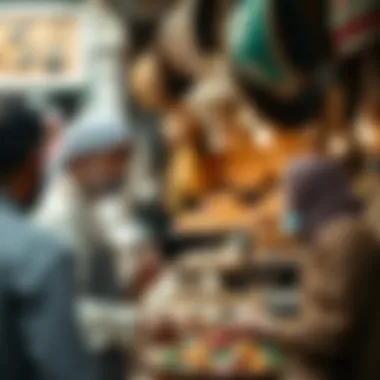

In summary, the modern adaptations of alsouq reflect a balance between maintaining cultural authenticity and meeting the evolving demands of contemporary consumers. For anyone looking to engage with Dubai's real estate or business landscape, understanding these dynamics is invaluable.
Comparative Analysis with Global Markets
Understanding the dynamics of alsouq in Dubai requires a broader perspective, particularly in relation to traditional markets existing globally. This comparative analysis can reveal the distinct characteristics as well as the common threads that bind different markets across continents. By highlighting these aspects, we can better appreciate the nuances and the cultural intersections that make alsouq a vital player in both local and international contexts.
Cultural Parallels
A wise saying goes, "Different strokes for different folks," and this rings true when we examine cultural aspects of traditional markets worldwide. Markets like the souks of Marrakech, Morocco, or Madrid's Mercado de San Miguel each reflect the unique interactions of local traditions and globalization.
At alsouq, you'll find a rich tapestry of Arabic cultural elements seamlessly weaving into daily transactions. This is akin to the Mercado in Mexico City, where colors, flavors, and sounds merge into a snapshot of vibrant Mexican life.
- Vendors and Shoppers: In both locations, a close-knit vendor-customer relationship highlights communal ties. Vendors often engage in friendly banter with shoppers, and these interactions often transcend simple buying and selling.
- Product Diversity: Markets always mirror their local culture. While alsouq boasts spices, textiles, and handcrafted items, Liwan, a traditional market in Lebanon, showcases artisanal jewelry and local foods. These differences highlight not only the unique values of each culture but also the shared human experience of trade.
Economic Comparisons
The economics of alsouq juxtaposes interestingly against global marketplaces like Bangkok's Chatuchak Weekend Market or Istanbul's Grand Bazaar. Key economic factors often come into play:
- Market Structure: Markets like alsouq rely heavily on local producers and artisans, enabling a direct link between origin and consumer, often missing in larger, globalized retail chains.
- Pricing Strategies: In contrast to automated pricing models of e-commerce giants, traditional markets often engage in negotiations reminiscent of old ways, instilling a semblance of personal touch in pricing. Research shows that this type of economic engagement can build deeper connections between sellers and buyers.
- Impact of Currency Fluctuations: Just as in other national markets, currency shifts affect purchasing behaviors and marketing strategies at alsouq. A weak local currency may improve attractiveness to tourists seeking cost-effective shopping experiences, precisely mirroring scenarios seen in markets like Egypt’s Khan el-Khalili.
Tourism Dynamics
Tourism plays a monumental role in shaping traditional markets, making it a pivotal consideration in our analysis. Alsouq thrives on both local patronage and the influx of tourists, similar to markets in other world-class cities.
- Visitor Experience: A commonly shared theme among global traditional markets is the immersive visitor experience that they provide. Tourists are not just buyers; they become part of a narrative full of sights, smells, and sounds. For instance, at the souq, the call to prayer can punctuate the hustle and bustle—a unique flavor often missing in Western market experiences.
- Marketing Strategies: Traditional markets increasingly rely on tourism by concocting experiences tailored for international visitors. Events, local food tastings, and craft workshops serve to engage tourists, much like how vendors at the Chelsea Market in New York cook fresh dishes to attract foodies.
"Markets thrive on their cultural identities and have the ability to engage with customers well beyond mere commercial transactions."
As we advance in this analysis, it is essential to realize how alsouq integrates itself into not just Dubai’s economic framework, but also how it stands as testament to the resilience and adaptability of traditional marketplaces in an age increasingly dominated by technology and e-commerce.
Integrating this knowledge enables investors, buyers, and real estate professionals to navigate and leverage opportunities stemming from the intricate relationship between markets like alsouq and their global counterparts.
Community Engagement through Alsouq
Engagement at alsouq is not just a social aspect; it's a cornerstone of the community's fabric. These bustling markets are where traditions and modernization intersect, creating lively spaces for interaction among local people, visitors, and traders. In this dynamic environment, the sense of community thrives, which in turn reinforces cultural identity and local ownership. There are several elements within alsouq that foster this engagement.
Local Events and Festivals
Throughout the year, alsouq plays host to a myriad of local events and festivals that bring together residents and tourists alike, creating vibrant atmospheres that celebrate the shared heritage of Dubai. These occasions include cultural festivals showcasing traditional music, dance, and crafts. For instance, during Eid celebrations, you might find stalls adorned with festive decorations, offering an array of sweets and handmade goods. Such gatherings not only provide a platform for local artisans but also encourage neighborhood cohesion.
Highlights of Local Events:
- Seasonal Festivals: Celebrating significant cultural and religious occasions, which draws larger crowds.
- Food Festivals: Where local cuisines are promoted, encouraging culinary exploration.
- Art Shows: Featuring local artists and their work, highlighting the rich creativity present within the community.
These events serve as a promotional tool for the market, gently nudging visitors to explore the offerings and experiences within the alleys.
Cultural Exhibitions
Cultural exhibitions at alsouq present an excellent opportunity for residents to engage with their heritage while introducing visitors to the rich tapestry of Emirati culture. These exhibitions often showcase handmade crafts, historical artifacts, and artistic expressions that tell stories of the past and present. Picture artisans demonstrating traditional weaving techniques or calligraphy, inviting spectators to try their hand at these age-old crafts. The educational aspect of these exhibitions not only enlightens but also reinforces pride in cultural traditions.
Examples of Cultural Exhibitions:
- Tradition in Focus: Showcases Emirati heritage through art.
- Craftsmanship Stalls: Where skilled artisans teach and demonstrate their crafts.
- Historical Tours: Guided walks through the market highlighting historical significance.
At these exhibitions, the focus is on interaction; they encourage visitors to ask questions and engage directly with the creators, making the experience memorable.
Workshops and Educational Programs
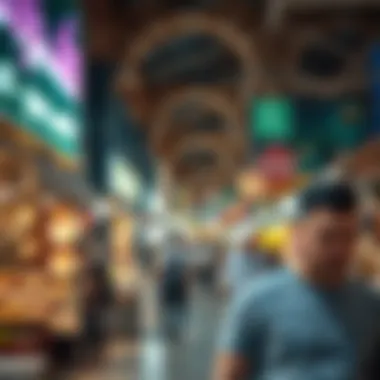

Workshops held in alsouq further enhance community engagement by offering hands-on learning experiences. These programs vary from cooking classes featuring traditional dishes to artisan workshops where attendees can learn a craft, such as pottery or painting.
Such educational offerings not only build skills but also forge connections among participants, encouraging them to learn from one another. The presence of local experts leading these workshops fosters community pride and underscores the importance of passing down knowledge through generations.
Potential Workshop Topics:
- Cooking Classes: Mastering local cuisine with chefs who share their family recipes.
- Craft Workshops: Bridging gaps between generations through art and craft.
- Language and Culture Sessions: Teaching the basics of the Arabic language alongside cultural nuances.
Through these engagements, participants leave with more than just knowledge—they carry a piece of the community and its heritage, creating a cycle of continual learning and growth.
“The pulse of alsouq is not merely in trading goods but through the connections that are made and the stories that come alive.”
Overall, engagement through alsouq cultivates a sense of belonging and pride, ensuring that as Dubai evolves, the community within these traditional markets remains strong and vibrant.
Challenges Facing Traditional Markets
As Dubai embraces a fast-paced future, the challenges facing traditional markets like alsouq become more pronounced. It’s crucial to shed some light on these challenges because they shape the experiences of both vendors and consumers. Understanding these hurdles is essential, particularly for investors, buyers, and real estate agents who are considering whether to engage with traditional markets or tap into the modern retail landscape.
Economic Pressures
Economic pressures are a major concern for many traditional markets in Dubai. The rise in cost of living, alongside increased operational costs for businesses, impacts vendors significantly. For instance, renting a stall in alsouq can be expensive due to the prime real estate location, making it difficult for small traders to make a profit. Additionally, inflation may lead to higher prices for raw materials, which inevitably gets passed down to consumers.
The economic crunch isn’t just about inflation; competition from bigger retail chains with better pricing strategies weighs heavy on the shoulders of traditional market vendors. As profits shrink, many traditional stalls find it hard to bring fresh concepts or products to the market. This stifling economic environment can create a ‘vicious cycle’ where declining sales lead to budget cuts, reducing the attractiveness of these traditional markets to both consumers and tourists.
Regulatory Issues
Navigating the maze of regulations can be like trying to find a needle in a haystack for market vendors. Regulatory frameworks governing traditional markets in Dubai can sometimes be restrictive and cumbersome. Licenses, permits, and other bureaucratic requirements can create barriers to entry for new vendors hoping to set up shop.
Moreover, some may argue that regulatory compliance often leans toward favoring larger businesses. Smaller market traders might find it more challenging to keep up with the regulatory standards due to limited resources. Changes in regulations can also impact how these businesses operate, directing them to comply with standards that might not align with traditional practices. This creates a potential clash between preserving cultural heritage and maintaining compliance with modern regulatory measures.
Competition from Modern Retail
The rise of modern retail options, such as shopping malls and e-commerce platforms, presents a tough challenge to traditional markets. The convenience and variety offered by these modern retailers can lure consumers away from the bustling alleys of alsouq. For instance, shoppers today often prefer the one-stop-shop convenience that supermarkets offer, making it difficult for traditional markets to maintain their footing.
Moreover, online shopping has dramatically influenced consumer behavior. The simple click of a button can deliver products to the doorstep, often with competitive pricing and a wider selection. Traditional markets, on the other hand, may face difficulties updating their offerings to compete with such convenience. This shift in consumer habits has pressured traditional vendors to innovate or risk becoming obsolete in the face of modern retail.
Creating a strategy that highlights the unique value of alsouq could be key in offsetting these challenges. A focus on authenticity, cultural experiences, and quality craftsmanship can draw back those still yearning for traditional shopping experiences.
Future Outlook for Alsouq
Looking ahead, the future of alsouq in Dubai presents a blend of opportunity and challenge, reflecting both the resilient spirit of tradition and the evolving needs of the modern era. This section navigates through potential growth areas, the role of alsouq in urban development, and how global trends are shaping its trajectory. It’s essential for stakehollders—investors, buyers, real estate agents, and developers—to understand these dynamics, as they forge plans to capitalize on the historical and cultural essence of these markets.
Potential Growth Areas
- Strategic Revitalization: Several areas within the traditional markets are ripe for revitalization. Efforts aimed at enhancing the shopping experience, such as improved infrastructure, can attract more visitors. Emerging technologies like mobile payment systems could also streamline transactions, making alsouq a convenient choice amidst high-tech competition.
- Broader Product Offerings: To sustain relevancy, alsouq can diversify its product offerings. By integrating artisanal goods alongside traditional merchandise, vendors can tap into both local and tourist markets.
- Culinary Experiences: Food stalls and local delicacies are moving to the forefront. Hosting culinary festivals or pop-up events showcasing local chefs can draw in significant crowds while stimulating local pride.
In these contexts, alsouq has vast potential to evolve, thus remaining a cornerstone of Dubai’s cultural landscape.
Role in Urban Development
Alsouq holds a rather significant place in urban development as communities continue to expand. Integrating these traditional markets within the urban fabric underscores a city’s identity and aids in cultural preservation.
- Urban Planning: City planning strategies increasingly include alsouq as focal points for development. The blending of contemporary architecture with traditional designs can lead to unique urban spaces that celebrate history while catering to growth.
- Community Spaces: Alsouq can serve as community hubs—places where locals and visitors can connect. By fostering a sense of belonging, these markets contribute to social cohesion, which is crucial in a rapidly changing urban environment.
By building stronger ties between the community and alsouq, the market can not only thrive but can also serve a higher purpose within the context of urban culture.
Impact of Global Trends
Today, alsouq does not operate in isolation; it exists within a global context. Observing broader trends can inform local decisions and adaptations.
- Sustainability Movements: With an increased focus on sustainability, alsouq can embrace eco-conscious practices. Vendors that prioritize local and organic products not only appeal to environmentally-minded consumers, but also stand to gain from broader trends toward health and wellness.
- Digital Transformation: As online shopping sees unprecedented growth, combining traditional and digital realms becomes paramount. A balanced approach can enhance customer engagement while preserving the essence of the market experience. Consideration of e-commerce strategies could attract a tech-savvy clientele without overshadowing the traditional offerings.
"A coalescence of the digital world with traditional markets may just be the lifeblood needed to reinvigorate alsouq in the coming years."
Through understanding these global trends, stakeholders can approach their investments in alsouq with greater foresight, ultimately fostering an environment conducive to harmony between heritage and modernization.



